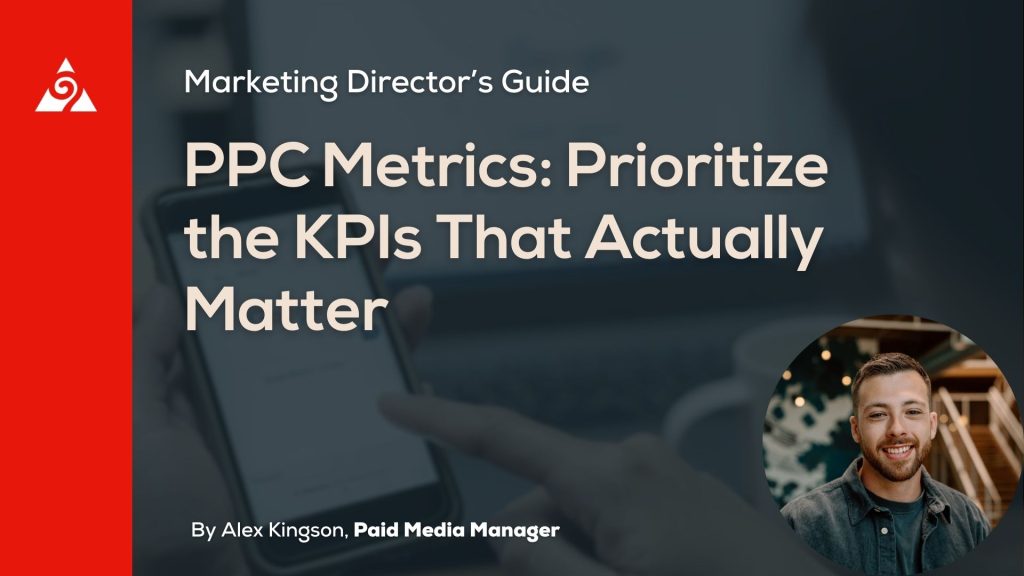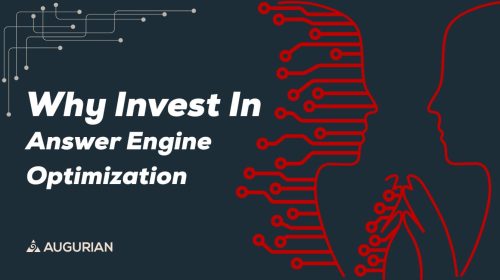Many brands are stuck investing time and money into paid advertising, expecting more leads and sales, but the results aren’t what they hoped for. Your data can feel like a cluttered room, with piles of numbers everywhere. Your team or agency might be throwing a bunch of metrics at you that are hard to understand, making it tough to find confidence in their direction.
Knowing which important PPC metric matters to clean up and improve your campaigns is important.
Paid ads are great because you can measure almost everything. You get data on views, clicks, bounces, conversions, and more. This detailed info is something traditional ads can’t provide.
However, not all data is useful for determining the strategic direction of your campaigns. When you or your team start A/B testing or optimizing ads, you must focus on the right metrics to guide them.
Before you jump into the paid metrics…
Ask yourself, “Which funnel stage needs the most impact?” You might want to boost brand awareness or capture bottom-funnel conversions.
Trying to track every single metric can feel overwhelming and confusing. Not every metric matters equally across all stages; without a clear system, it’s hard to understand everything.
Guess what? As a marketing leader, you’re not responsible for understanding everything.
The funnel model helps you identify the problem and organize your metrics into meaningful categories: traffic, conversions, and revenue. This approach allows you to:
- Understand What Metrics Matter Where: By categorizing metrics into traffic, conversions, and revenue, you can pinpoint which metrics are crucial for your specific goals at each stage.
- Make Strategic Changes: Knowing which metrics to focus on helps you make informed decisions to adjust your strategy effectively.
- Identify Key Levers: Understanding traffic, conversion, and revenue metrics helps you and your team know which levers to pull for better performance at each stage.
- Track PPC Metrics: Utilize reporting and dashboard tools to pull data from various paid marketing platforms and create personalized or ready-to-use PPC campaign dashboards.
Paid Ads Metrics that Matter
Each metric is connected to concrete outcomes in ad campaigns. By monitoring and evaluating them, you can confidently guide your paid media team (or yourself) to success.
1. ROAS (Return on Ad Spend)
What is ROAS?
- Definition: ROAS stands for Return on Ad Spend. This metric tracks how much money you make from your ads compared to how much you spend on them, emphasizing the importance of continuously monitoring and optimizing your ad campaign.
- Why It Matters: A higher ROAS means your ads make more money. It shows how well your campaign is doing.
- Funnel Stage: Middle to Bottom – Relevant for stages where you assess the financial efficiency of your campaigns.
Why Measure ROAS?
- Monetary Performance: It shows the financial success of your paid ads.
- Campaign Comparison: This helps you compare how different campaigns are performing.
3 Ways to Improve ROAS
- Segment Campaigns: Send the right message to the right audience.
- Target High-Value Accounts: Focus on customers who spend more money.
- Increase Revenue: Use Conversion Rate Optimization (CRO) to boost sales and improve ROAS.
2. LTV (Lifetime Value)
What is LTV?
- Definition: Lifetime Value (LTV) measures the total profit you make from a customer over the time they do business with you. It shows how much a customer spends before they stop buying from you.
- Funnel Stage: Bottom – Important for the retention stage, focusing on long-term customer value.
Why LTV Matters
- Long-Term Focus: Tracking LTV helps you build long-term relationships with customers. This makes your investment more valuable over time and increases future sales.
- Repeat Business: High LTV means customers keep returning, which is crucial for growing your business. It’s an important metric for your paid efforts.
3 Ways to Increase LTV
- Retargeting Campaigns: Show ads to your target audience who have already visited your site or interacted with your brand. This will remind customers of your products and encourage them to return and purchase more.
- Personalized Ad Messaging: Create ads tailored to your customers’ interests and behaviors. This will make customers feel valued and understood, increasing their likelihood of returning.
- Promotions and Special Offers: Use paid ads to promote exclusive deals, discounts, or loyalty programs. This encourages repeat purchases by offering customers incentives to return and buy more.
3. CPA (Cost per Acquisition)
What is CPA?
- Definition: It tracks how much you spend to acquire a new customer through your paid ads, often called the cost per conversion.
- Why It Matters: Knowing your CPA helps you control costs and set realistic goals for your advertising budget.
- Funnel Stage: Bottom – This is important for the conversion stage, as it directly reflects the cost-effectiveness of acquiring new customers.
Why Measure CPA?
- Cost Control: It helps you see how much money you spend to get each new customer.
- Direct Revenue Impact: CPA is closely linked to how much you spend to earn revenue.
- Effective Budget Use: You can set better spending limits based on your audience and what you’re selling.
3 Ways to Lower Your CPA
- Trim Unnecessary Spend: Cut out underperforming campaigns and keywords to save money.
- Add Negative Keywords: Use negative keywords to make your ads more relevant and reduce costs.
- Reduce Max Bids: Lower your maximum bid to decrease your spending.
4. Conversions
What are Conversions?
- Definition: Conversions track the number of users who do something you want, like buying something or filling out a form.
- Why It Matters: Tracking conversions helps you see how well your ads work, especially in relation to PPC ads.
- Funnel Stage: Middle to Bottom – Vital for determining the effectiveness of your paid efforts in driving desired actions and turning leads into customers.
Why Measure Conversions?
- Campaign Health: Conversion volume shows how well your campaign is doing. If conversions are low, you need to make changes.
- ROI/ROAS Growth: More conversions mean better returns on your ad spend.
- Revenue Impact: More conversions mean more revenue. You’ll make more revenue by increasing conversions and keeping your costs the same or lower.
- Optimizable Metric: Improving conversion volume is easier than improving conversion rates.
3 Ways to Improve Conversion Volume
-
- Optimize Landing Pages: Make sure your landing pages are easy to use, load quickly, and have clear calls to action. Test different designs to see what works best.
- Refine Ad Copy: Write clear and compelling ad copy that addresses your audience’s needs. Use strong calls to action.
- Expand Keyword Pool: Add more relevant keywords to your campaigns. This can help reach more people and increase conversions.
5. Conversion Rate
What is Conversion Rate?
- Definition: Conversion rate measures the percentage of visitors who take the action you want after clicking on your paid ads. This could be filling out a form, making a purchase, or achieving another goal you set. Understanding the total cost associated with these actions helps evaluate the overall expenditure and efficiency of your ad campaigns.
- Why It Matters: It shows if your paid ads and landing pages get people to do what you want them to do.
- Funnel Stage: Bottom – Crucial for the conversion stage, where increasing the order size can boost revenue.
Why Measure Conversion Rate?
- Performance Indicator: Conversion rate is a key metric showing how well your paid campaign works. It tells you if your ads and landing pages are convincing enough for people to take action.
- Lead Generation: A good conversion rate means your ads successfully bring in leads from your target audience, and the landing page converts them.
3 Ways to Improve Conversion Rate
- Include Clear CTAs: Make sure your call-to-action (CTA) is clear and strong, guiding users to do what you want them to do.
- Enhance Landing Pages: Improve your landing pages to make them user-friendly, relevant, and attractive to visitors.
- Adjust Bids: Optimize your bids to attract more interested visitors, increasing their conversion chances.
6. AOV (Average Order Value)
What is AOV?
- Definition: Average Order Value (AOV) measures the average amount of money customers spend per order.
- Funnel Stage: Bottom – Crucial for the conversion stage, where tracking traffic sources from search engines and increasing the order size can boost revenue.
Why Measure AOV?
- Customer Insight: Tracking your AOV weekly or monthly helps you understand how much customers spend on average.
- Revenue Indicator: AOV is directly tied to revenue, making it a useful metric for evaluating your campaign’s success.
3 Ways to Improve AOV
- Target High-Value Keywords: Focus on keywords that attract customers who are likely to spend more. This can bring in shoppers looking for premium products.
- Use Ad Extensions: Implement ad extensions to highlight special offers, product bundles, or discounts, encouraging larger purchases.
- Promote Higher-Priced Items: Create paid ads that specifically promote your higher-priced items or bestsellers to increase the average order size.
Focus on PPC Metrics That Matter to Leadership
As a marketing leader, you are accountable for impacting the company’s bottom line. Focusing your team on the right metrics is important because they directly impact your revenue.
Don’t get caught up in details like impression share and CPC. Even popular PPC metrics, like quality score, are now losing their importance. Your team should handle staying on top of them and translating those directional metrics so you can understand how they impact your paid KPIs. Connecting your Google Ads account to different dashboard templates can help you monitor and optimize your campaigns. Your job is to direct resources and guide strategy based on their feedback and the results you see.
By prioritizing these key paid metrics, you can improve your campaigns and get better returns on your investment. This will help you feel more confident managing your paid media strategy.
Need some help with prioritizing what matters to your paid media efforts? Take a look at our Free Paid Media Diagnostic. 👇🏼
- PPC Metrics: Prioritize These 6 PPC KPIs That Truly Matter - June 21, 2024





